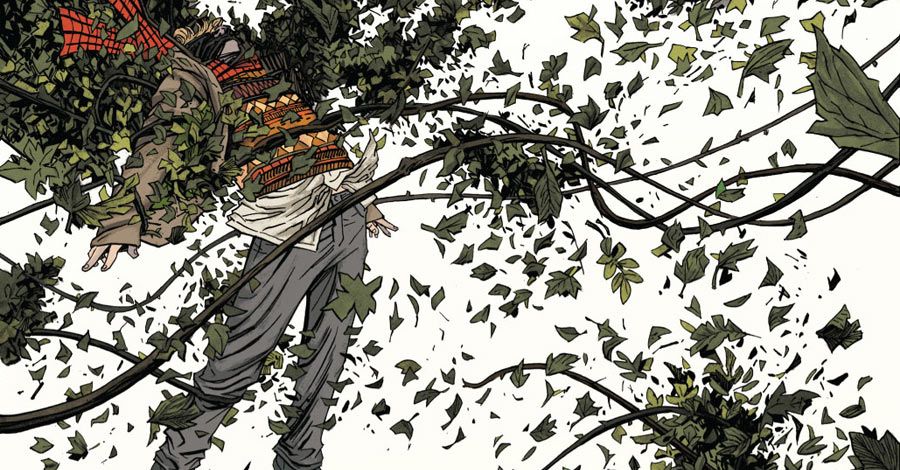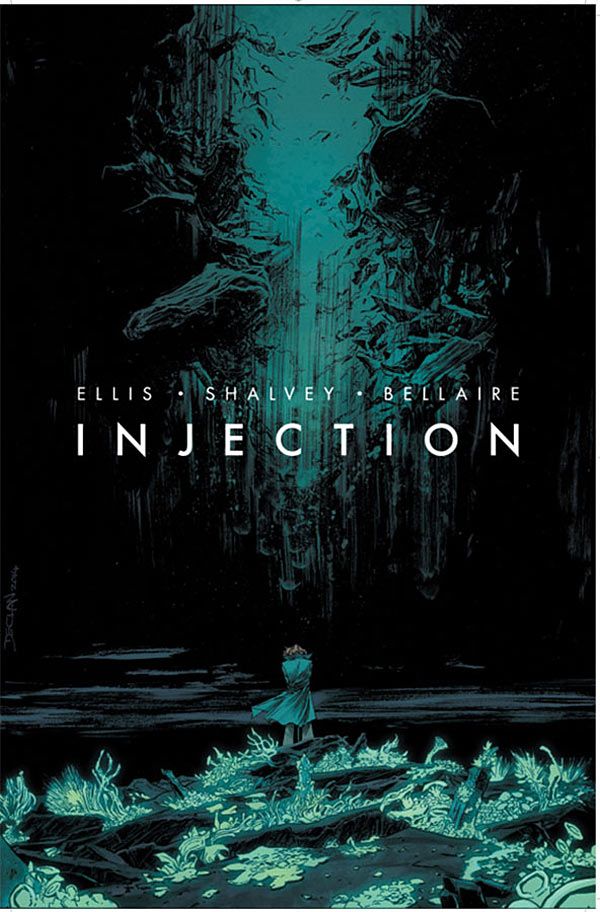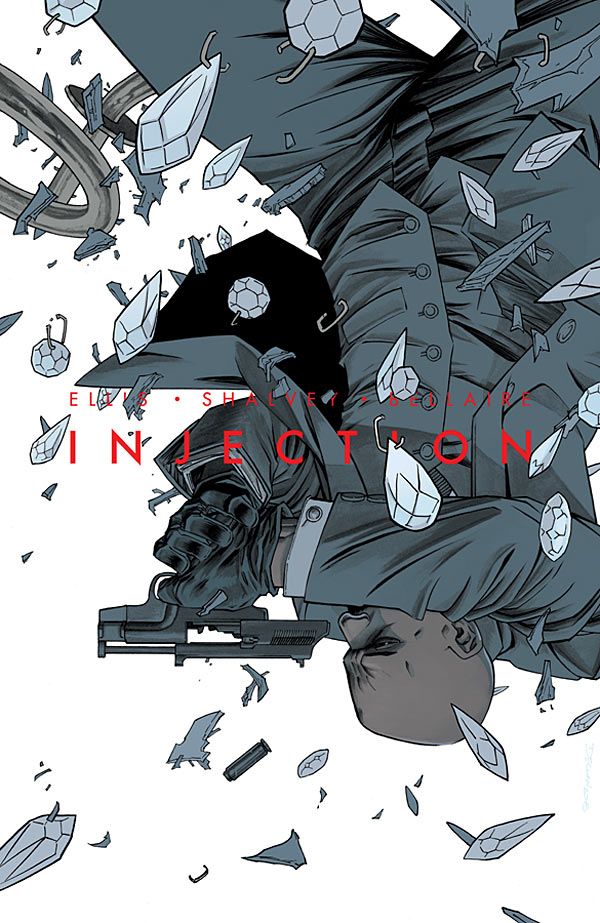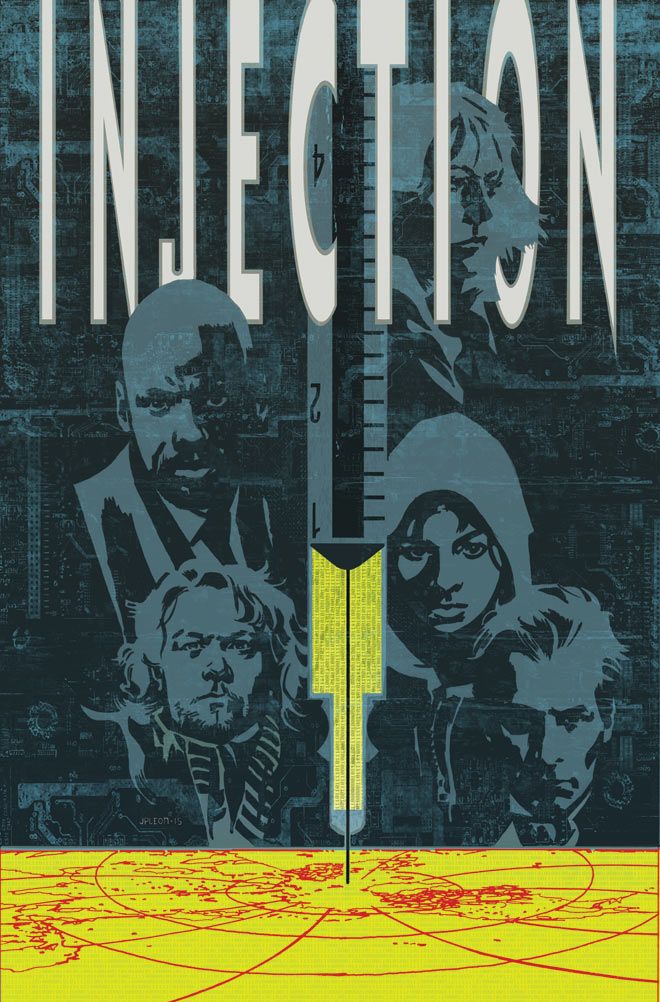The world is poisoned, nearly broken and on the verge of apocalypse. Experimental research has yielded devastating results, and now a team of scientists seek the cure. With all that's stacked against them, the only saving grace is that they're on familiar ground, seeing as how they are the ones responsible for the current situation.
Led by Maria Killbride, five former agents of the British government seek to undo the damage they caused years ago with their mysterious project known as "Injection." 

Written by Warren Ellis especially for his "Moon Knight" collaborator Declan Shalvey, "Injection" premieres May 13 from Image Comics. Eisner Award winning colorist Jordie Bellaire and lettering master Fonografiks complete the team. Drawing from Ellis' keen observations on technology and folklore, "Injection" is a series that might just redefine the scope of dystopian science-fiction.
Shalvey spoke with CBR about his work on the series, including the subtle mastery of Bellaire's work, his unique approach to building an apocalyptic world, and the pressure he feels to deliver high quality work.
CBR News: Declan, as "Injection" readies to premiere, what aspects are you most proud of? What are you most nervous about?
Declan Shalvey: That's hard to answer; this is such a new experience, it's hard to single out one aspect to it. I guess I'm most proud of bringing something new to the stands. I've always tried to do something interesting with work for hire projects, but essentially you're taking a property and playing with it -- something I've been doing for years now, and having a lot of fun doing so. What's different is that this book never existed until Warren and I put it together (along with Jordie Bellaire and Fonografiks). It's undeniably ours, and while many, many people have done this before me, it's a completely new experience for me, and a very rewarding one.
Of course, since it's all on my back (Warren, Jordie and Fonografiks have done all this before) I am very much feeling the pressure. If it's not good, then I'm going to feel that the fault is mine.
You and the team have delivered an incredibly beautiful first issue, and with the talent of you, Jordie and Fonografiks, there's a lot of vision and style to draw from. How are each of you bringing something new to the series?
Why thank you! I really appreciate that. Don't forget that Warren Ellis fella, I hear he's written a thing or two. And to be frank; Warren is providing the material that informs the artwork. I'm not drawing in a vacuum; Warren is giving me all the resources I need for me to do my best work, which is what I'm trying to bring to the book. I'm trying to build a story with a very restrained, but fully developed world, and then tear it apart bit by bit. Jordie is taking my work, and breathes glorious life into it with her color approach. Fonografik's singular and specific design aesthetic is the icing on the cake. He helps to create an identity for the book and the artwork. It's very important that when you open this book it looks like a page from "Injection" and nothing else, and each part of the creative team add something vital to the series.
Jordie is a very well-established creator for Image. What's some of the most important expertise she's brought thus far?
Em... an Eisner Award?
Seriously though, I don't think it's any coincidence that people really started to respond to my work once Jordie and I started to work together consistently. She really does enhance everything I do; if I'm going for a powerful moment, she makes it more powerful. If I'm invoking a mood, Jordie makes it moody as hell. If there are more nuanced techniques I'm trying, she delicately handles them to make them work. Jordie just knows how to make every page, every panel better I draw 20 times better. She doesn't just "add color," she brings ideas to the table. We don't always agree, but I learned long ago that if Jordie has an idea it's worth hearing as 9 times out of 10, it'll make the work better and more interesting.
From a more practical level, while I was building a name for myself, Jordie worked on many creator-owned projects at Image. In the time since, she has seen how some can run off their tracks, so she's far more aware of when something needs to be in, and what complications can arise. She's like my spider-sense when it comes to managing a creator-owned project, and it's been a huge benefit. Without her experience, I'd really be flying blind.
Did you have an idea of the direction you wanted to take the art in as soon as you and Warren began discussing the series? How has it changed over time?
I definitely did know what direction I was going in. "Moon Knight" was very much the launch-pad as regards the art style; it's where I developed the techniques I wanted to try and it worked out well. There was a more 'cinematic' approach I tried on that book that really worked for our collaboration, and I think Warren is writing "Injection" with that in mind. I had tried using washes on my sequential work, and it turned out really well, so decided to continue that on this series. I've noticed since starting however, that I've been 'sculpting' more. I find that I'm slowly fleshing and refining things. Maybe it's because I'm also creating these character and environments, but even with using the greywash, it feels more like painting than simple rendering. Jordie has brought such a delicate touch to her rendering, too; I see under the linework, and everything she's doing just enhances my work with an almost invisible touch. It takes a lot of effort to make work that subtle.
The one change in approach is how the flashback scenes are drawn in plain black ink, so I find it interesting to jump from one approach to the other. Less is more, with this book.
In one of Warren's weekly newsletters, he said that Issue #3 of "Injection" is where we can see you become the artist you're going to be remembered as. What have you discovered about yourself as a storyteller during this process, and did that issue's work stand out as something very special for you as well?
No pressure there, then. Well, in fairness to Warren, #3 is where some of the 'weirder' elements start seeping into the book, and much like on "Moon Knight," Warren continues to provide me with new challenges. There's an especially creepy scene in #3, and I spent a little longer than I should have making it come to life. When you're drawing comics you have to know when to get your pages in and when to put in some serious work to show off. The aim is to do both good work and get the book in on time. With #3, I had the liberty to take a little longer, let some ideas gestate in my brain a little, then take the time needed to make it work on the page. Getting to #3, I think I just found my feet with the series more. Each character had been featured at this point; no more awkward introductions, I can now get stuck in and really develop these characters.
I love those newsletters Warren does as that's where I find out more about what "Injection" is actually about than in the scripts! I also get to read the odd compliment from him, though I suspect I've just killed that habit now.
Let's talk a little bit more about the story -- in the first issue, we meet Maria Killbride, a scientist working for a company responsible for poisoning the Earth. What about her character was important for you to convey when designing her?
She's a crazy, eccentric genius, so that was the main thing to get across. I wanted to make sure she looked tired without looking old, which is a difficult balance. We see her a few years ago (pre-Injection) too, and I wanted to make sure we connect that it's the same character, but a few years ago, Maria was more full of life and optimism. It was important the reader feel like i the time passed, something has sapped Maria of her optimism. She's out anchor as the series begins, so I felt it was important we empathize with her, even though she's quite broken when we meet her. Developing a visual timeline for all the characters has been very important and for me, Maria has been the real emotional anchor so far.
Maria and her team were given a lot of freedom to do their research that led to The Injection -- does that have a similar feeling to what its like working in creator-owned comics? Brilliant minds converging to create something wonderful with the risk that it could become something unexpected?
Heh, they made something that destroyed the world -- who knows what we'll destroy with this book?! Probably my sanity. This is a unique challenge for me, though. "Moon Knight" was the first series I got to develop, and while I'm quite proud of what we did (it stands as the best work of my career), I don't own it. The personal investment I have in this series is very new for me. It's made me more confident about the work that I want to be doing from now on, and the satisfaction in the work has been amazing. I can make choices about this series that are my own. I had the idea of doing a variant cover that is just a sandwich and now we have that cover. The decisions are our own and while it's amazing to have such options, I will admit a certain fear comes with them. If the book fails, there's no one to blame but myself, especially with such an amazing team of Warren, Jordie and Fonografiks.
But their team was the Cultural Cross-Contamination Unit. It speaks to the idea of interconnectedness, which is a defining characteristic of the 21st Century. How does their idea of cross-contamination relate to our world?


"Injection," for the most part, is the world outside our own door. In the series we are contaminated, and we're going to see that contamination grow and spread. Reality, mythology, scientific theory, it all blends together more and more, and The Injection plays a major part in this contamination of our world. The Injection speaks to technology in our contemporary existence. We're very much leaping into the unknown, while still all tied together. These ties are unlikely to be cut; they're more likely to become tangled, therefore we all become entangled with each other. There is no escape.
Although it's set in a dystopian world, the book has a distinctly rich, expressive feel to it, unlike many other dystopian worlds we've seen that feel ravaged. What feelings are you evoking through these choices? And how does a dystopian world look to you?
While an Apocalypse is most certainly looming, I don't feel we're quite at that dystopian stage. I want this world to feel rich and developed. The more palpable it is, the more tragic is it's when we scar and ruin it. I personally love drawing miserable, post-apocalyptic environments with dull, desaturated colors, etc, but it has been done often. I think it's more interesting to draw a healthy world and see it die, shift the environment from one state into the other. See the dead amongst the living. If the series does well we'll have the space to do that, which will be a really interesting challenge.
The idea of blending folklore and technology in "Injection" creates a truly sci-fi world, where just enough feels familiar and yet transports the readers somewhere very new. How do you balance these things in the storytelling?
As I may have teased before, I've gone to great efforts to make the book look rich, developed, tangible, but not too sensational. There will be moments of curiosity, horror and fantasy, but in order for those to be of most dramatic effect, I need to make sure those fantastical elements are genuinely spectacular. The 'unbelievable' is all the more awesome if the building beside it is grounded in a fully developed environment.
"Injection" infects comic stores May 13 via Image Comics




